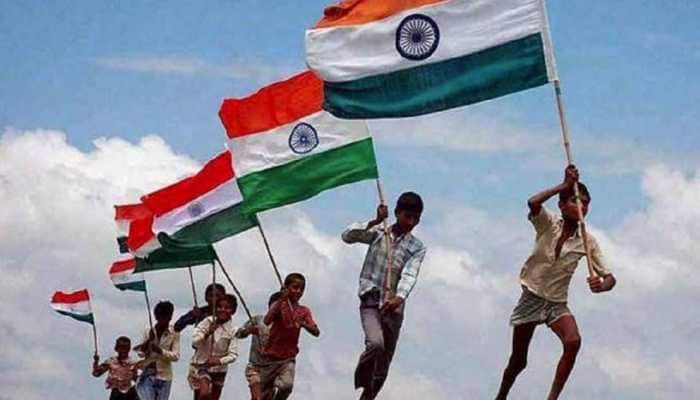History books across India are filled with grand stories of the Indian independence struggle
21-Sep-2022
1036
Dr Anirudh sudhanshu
.History books across India are filled with grand stories of the Indian independence struggle Turn to any page of those books and you'll find tales of brave men and women who stood in open defiance of the British Raj even in the face of death and those who chose a more silent path. But there is another facet of this struggle, one that is not spoken of nearly as much as it should: the Press.The British Raj, as is known, was filled with great misery for the Indian citizen who lived under great duress and stress of being a mere colonial entity rather than their own being. Many newspapers did not take well to that reality and chose to highlight the plight of the people in hopes of creating a movement for swaraj.
It began in 1780 with the first printed newspaper in India, the Bengal Gazette. Run by Irishman James Augustus Hicky, the paper was noted and had infamy for its satirical tone and repeated ridicule of the British Raj, something Hicky was proud of and escalated every time he was sued or otherwise impeded by its agents. Unfortunately, the paper ceased to function in 1782, but it left behind quite the legacy.
As time went on, many newspapers took note of the Raj's strategy of using Hindu-Muslim discord as a weapon to distract people from any real attempt at revolting on a nationwide scale. In 1857, during the first war of independence, the newspaper Payam-e-Azadi took to spreading the message that the British would continue to divide and rule and that people had to stand up against it.Alongside that, existed three newspapers: Samachar Sudhavarashan, Doorbeen and Sultan-ul-Akhbar, which were suppressed for their critical view of the Raj.
The British, of course, never took anything that might threaten their rule lying down. The Raj instituted a number of censorship measures from the early 1800s, at least one of which still survives to this day: the Sedition clause.
But the Sedition clause was alone not enough for the British: they instituted the Vernacular Press Act in 1878, aimed squarely at suppressing non-English papers from criticising the Raj, for the voice against the colonial rule had risen greatly after the famine in 1876.
As though a tit-for-tat, Indian newspapers too refused to take gag orders and threats of prison lying down. Perhaps it was the century-long arduous rule or simply because they were tired of it, the Press soldiered on, using creative means to circumvent censorship. One of the most notable examples of this is Nil Darpan, a play published in The Hindoo Patriot, which was a critical move leading to the Indigo revolt in 1859.
One of the most infamous targets of the Sedition clause was Bal Gangadhar Tilak, who was tried and convicted thrice, one of which was defended - unsuccessfully - by none other than Muhammad Ali Jinnah.
As the nationalist movement gathered steam going into the 1900s, especially after the establishment of the Indian National Congress - which had many prominent newspaper editors in its first sitting and as prominent leaders - the Raj began a major crackdown of the Press by passing one Act after another, like the Prevention of Seditious Meetings Act of 1911, Press Act of 1910, and Criminal Law Amendment Act of 1908. The most disastrous of the Acts passed was the Press Act of 1910, which brought over 1,000 newspapers under prosecution and made the Raj's pockets heavier by Rs 5 lakh in form of securities and forfeitures.
Near the last decades of the Raj, when the Civil Disobedience Movement was well underway and Mahatma Gandhi had taken out the Salt March, the Press (Emergency Powers) Act was passed in 1931 and strengthened during the Second World War. The Act gave provincial governments power to suppress propaganda for the Disobedience movement and was later used as a weapon to ban all talk of the Congress.
As the War raged and Indians were drafted into the mess, the press in India formed the All-India Newspapers Editors’ Conference, with the aim to fight for the freedom of the press.
Towards the end of the Raj, though, pre-censorship continued. This was most evident during the 1943 Bengal famine, which was notably reported by the Amrita Bazar Patrika. The Raj went so far as to ban the press from telling the country that it was banned from talking about the famine just so it could be brushed under the rug, possibly owing to the debate that Churchill's animosity towards Indians led to him refusing to grant, or reducing food supplies to the region despite pleas by Louis Mountbatten.
The press, being the ever-clever entity it was, continued its resistance by using underground papers, radio, art and graffiti. This continued till the British finally abdicated from India, creating the two countries - India and Pakistan.
GEEKSFORGEEKS
Development of Indian Press During British Rule in India
All the Revolutions in the modern world have stood firm on strong foundations of information sharing. Indian National Movement in this sense was no different from the others. Press became the voice of leaders, a medium of information sharing, and a tool of criticism of the incumbent government and its policies. Portuguese introduced the Printing Press in India in 1550 and published a book in 1557. James Augustus Hickey in 1780 came out with the first newspaper in India named Bengal Gazette also known as Calcutta General Advertiser, earning him the title of ‘Father of Indian Press’. Among the Indians, Gangadhar Bhattacharya brought out the English version of the Bengal Gazette, thus he became the first Indian to publish a newspaper.
The emergence of newspapers was not favourable for the British as these newspapers could expose the tyranny of the British Officials who were serving in India to the European world. Raja Rammohan Roy has considered the Pioneer of Indian Journalism and in 1822 he started Samvad Kaumudi and the Persian weekly Mirat-ul-Akhbar. The policies of the British were consistently under attack by the educated Indians through various publications. Hence arose the need to sanction, censor and scrutinize the publication of various newspapers, journals and newsletters.
The Development of the Indian Press can be largely traced in Three Distinct Phases:
Pre 1857 War of Independence
1857-1914, Till the beginning of the First World War
1914-1947, Till the enactment of the Indian Independence Act, 1947
1. Pre-1857 War of Independence:
The various regulations via which the British burdened the Indian Press during this phase were:
Censorship of Press Act, 1799: Lord Wellesley anticipated a French invasion of British India and imposed various restrictions on the publications of that time via pre-censorship.
Licensing Regulations, 1823 (Adams’ Regulations): This brought the license raj to the Indian Press environment where a license was needed to establish or use the press. This was majorly directed towards the Indian language publications as they had grown critical of the British policies.
Press Act or Metcalfe Act, 1835: Proclaimed as the ‘Liberator of the Indian Press’, Charles Metcalfe did away with the Adams’ Regulations. The liberal approach of Metcalfe led to rapid strides of the Press in India.
Licensing Act, 1857: The government in the wake of the Revolt of 1857 reserved the right to suspend any publication from printing or circulation as and when it deemed fit.
2. 1857-1914, Till the beginning of the First World War:
British Government during the pre-1857 phase was largely focused on regulating the materials being published to maintain its image. Though censorship prevailed, it was largely limited. However, the Revolt of 1857 was a jolt to the British. They quickly took corrective actions to prevent such a massive agitation again. Reactionary policies of the British antagonized the educated section of Indians which began open criticism of the government via various publications. This did not go down well with the British authorities and up until the First World War, the British suppressed the Press severely in India. Various steps taken by them to undermine Press were:
Section 124A of the Indian Penal Code: Also known as the Sedition, this law prohibited individuals from causing dissatisfaction against the government via any means. However, nationalist leaders subverted these sanctions.
Vernacular Press Act, 1878: It was the highly imperialistic policies of Lord Lytton, the then Viceroy which prompted Indian leaders to criticize him vehemently. However, Lytton struck back with limitations imposed on the Vernacular Press. It was nicknamed the “Gagging Act”.
Newspaper Act, 1908: This law specifically aimed at the Extremists who incited the public for violent activities. Tilak was charged with Sedition and was sentenced to Burma which saw great protests across India. This marked the entry of the working-class into the Indian National Movement.
Indian Press Act, 1910: This Act was identical to the Vernacular Press Act, of 1878 and augmented some of its worst features. Security Fee was demanded the registration of a publication that could be de-registered if it violated any provisions
3. 1914-1947, Till the enactment of the Indian Independence Act, 1947
With the increasing social base of the Indian National Movement especially posts the Partition of Bengal, Press became a key weapon of dissemination of information. Hence since 1914, the Government began to crack down on the publications. Various measures taken during these times were:
Defence of India Rules, 1914: Under the garb of curbing misinformation during the war the British choked the Press to put an end to the public criticism that it had been facing.
Indian Press Act, 1931: This Act was brought into action against the backdrop of Dandi March. The peace that prevailed between the government and the Press for about a decade ceased. Severe repression of the Press took place which affected the Press across the country.
During the Second World War: Various Acts such as the Indian Press Act, 1931, and Defense of India Acts 1915 were amended to suit the political climate in the country which was filled with turmoil. At that time, any publication related to Congress was declared illegal.
During the Interim Government: Interim Government practically freed the Press from the British clutches. However, communal riots in the country forced them to take the route of Ordinance in order to put out the fires caused due to partition.
Early Nationalists like Sisir Kumar Ghosh, G.Subramania Iyer, etc. fought tooth and nail against the British to secure Press its voice and freedom. Fearless Journalism with no regard for the restrictions and punishments was the trademark of the Press of the British era. Though a small section of the Press rallied behind the government, a large section helped in exposing the true nature of British Rule. From Surendranath Banerjee to Bal Gangadhar Tilak everyone followed the words of James Augustus Hickey, “I take a pleasure in enslaving my body in order to purchase freedom for my mind and soul.”



.jpg)
.jpg)
.jpg)
.jpg)
.jpg)
.jpg)

.jpg)
.jpg)


.jpg)
.jpg)
.jpg)
.jpg)
.jpg)
.jpg)
.jpg)
.jpg)


.jpg)

.jpg)
.png)
.png)
.jpg)
.png)
.png)
.jpg)
.png)
.png)


.png)
.png)


